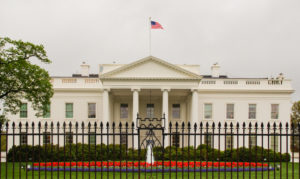The United States of America is a federal republic led by an Executive President residing at The White House, Washington DC, an area of about 170 km² (the district not the house! – Ed) sandwiched between Maryland and Virginia. The region should not be confused with Washington State on the Pacific seaboard.
The US Government is made up of 3 branches providing for an appropriate separation of powers – one making laws; one carrying out laws and one interpreting laws.
- The Legislative branch consists of a lower chamber; US House o
 f Representatives, and an upper chamber; US Senate. Both are located at Capitol Hill in Washington DC and together they make up the US Congress.
f Representatives, and an upper chamber; US Senate. Both are located at Capitol Hill in Washington DC and together they make up the US Congress. - The Executive branch – the President; Vice-President; and the Cabinet – members of which are nominated by the President and require 51 Senate votes for approval.
- The Judicial branch comprises of the Supreme Court and other high courts. There are 9 Supreme Court judges, who are nominated by the President and who require 51 Senate votes for approval.
The Senate comprises 100 senators – 2 from each of the 50 states; serving terms of 6 years each. Senate elections are staggered so that about 30 seats are due for re-election every 2 years. There is no cap on the length of time a Senator may serve, if re-elected. Currently, there are 51 Republican senators, 47 Democrats and 2 Independents. The US Vice-President acts as the Chair of the Senate and has the casting vote where ballots are tied. The so-called Majority Leader is the chief spokesperson for the party with the most Senate seats.
The House of Representatives has 435 seats that are allocated to states proportionate to population. California has 53 seats and Alaska has 1. Members are elected for 2-year terms and may seek re-election indefinitely. There are currently 240 Republican representatives, 193 Democrats and 2 vacancies. The Speaker of the House rules the roost as chief presiding officer – and automatically assumes the role of Vice-President or President, where circumstances dictate.
Congress functions by way of sub-committees with each chamber recommending its own initiatives. The US Senate does not meekly approve legislative proposals as typically happens in upper chambers elsewhere. In many instances, the Senate will not just reject what is being proffered by the House but will hit back with its own very distinct ideas. This has the effect of keeping the House in check and giving due expression to the views of every state (each has 2 Senators). But it can also lead to lengthy and frustrating exchanges. Ultimately, the President has the power of veto.
The Judicial branch interprets the meaning of laws and ultimately decides if laws offend the Constitution. The Supreme Court is the highest court and consists of a Chief Justice and eight other judges. A quorum of six members is required to decide a case. There is no fixed term – members serve until their death, retirement, or removal.
US Government; the way it should work!!

